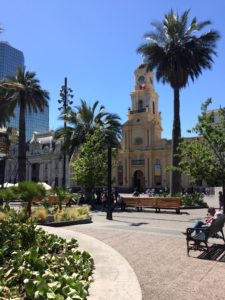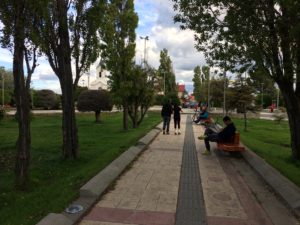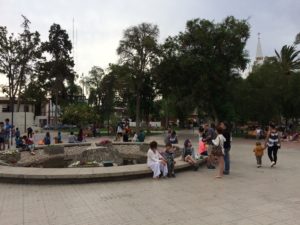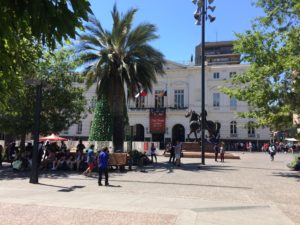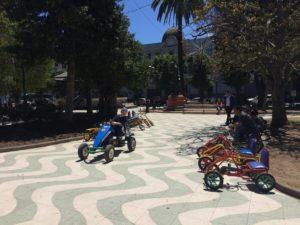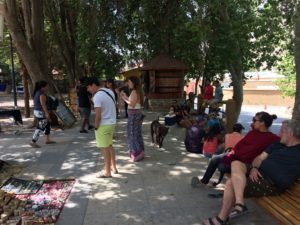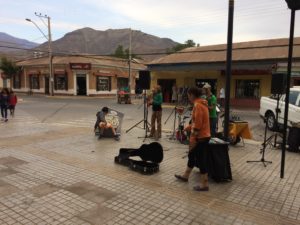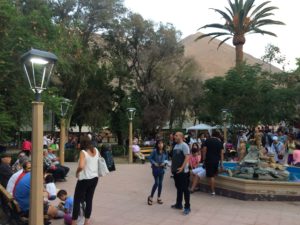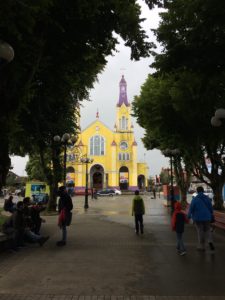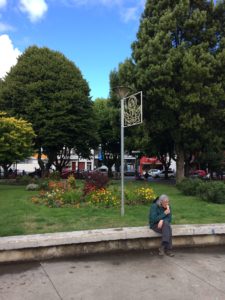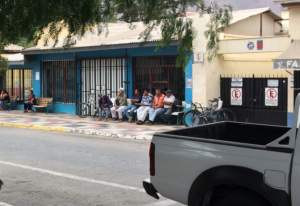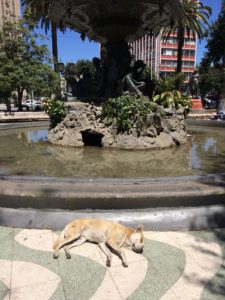Town Square
Everywhere we went on our recent trip to Chile our family could count on one thing: the town square. Up and down Chile, in any weather and any geography, big city and small village, we spent time in and around the town square. Day or night, we found them to be pleasant and active, with programming and informal gathering, something to bring all ages together.
In Santiago, the capital of Chile, the Plaza de Armas was full of people one mid afternoon. The square is ringed by lovely old buildings with a distinctly European, particularly Spanish look. Indeed, the European influence is likely the reason why squares are so common in Chile. And the solid wall of buildings surrounding the square provided that sense of enclosure and embrace. At the same time, the open space and sunshine of the Plaza de Armas is a welcome relief from the density in the surrounding bustle and warren of streets.
Town squares are accessible and traversable. When approaching from the surrounding grid of streets, most people arrive at a corner of the square. I’ve previously written about the importance of an X-shaped set of paths crossing a town square. The pattern certainly held in most cases we saw, including the Plaza Puerto Natales, where the X-shaped paths allow you to cut diagonally across the square or walk around the edge. And yes, even down in Patagonia, with frequent wet and windy weather, Puerto Natales, with fewer than 20,000 inhabitants, had a popular town square.
Most town squares have a middle, a central gathering place. Often you find a fountain or other monument there to provide a focal point and center of gravity. This is no different with all the examples we found in Chile. Typically the edge of these fountains provide a place for people to sit while their kids can run laps.
Although some basic design principles are typically adhered to, town squares are a reflection of their climate. In Santiago’s desert valley climate, even on a pleasant 80 degree day, people sought shade, and every shady bench and knee wall was occupied, with plenty of sunny options available as well.
Conversely, in Castro on Chiloe Island, I noticed a phone “booth” (what’s a phone booth!?) at the edge of the town square. It wasn’t a booth, per se, but the phone did have a roof to keep at least some of the frequent rains off the user, as the climate there is similar to Seattle or Vancouver. The roof had a nice buildup of moss from the years of wet weather.
Town squares are fun! Plaza de la Victoria in Valparaiso had these little four-wheel carts to rent, which made them by far the best value on our entire trip to keep our kids entertained. For something like $1 for 20 minutes, our kids could zip around the fountain or do laps around the perimeter of the square, or connect between the two on the many connecting paths.
Places to sit are critical, whether it’s to take a much-needed break or feed pigeons. In Valdivia, the Plaza de Republica provided a variety of benches along walkways and in alcoves like the one shown below, in both sun and shade. Knee walls and steps also provide significant additional informal seating when the town square gets busy or if a specific spot is in a desirably sunny or shady place.
Town squares have always been places of commerce. Even Apple is trying to steal the term town square for its stores. Real town squares in our time in Chile had a combination of semi-permanent food markets, temporary stalls and even informal wares laid out on blankets for the day. Commerce is found anywhere on the square, particularly along the perimeter where it is less intrusive on informal public gathering and can be arranged in a more linear, window-shopping fashion. Many cities’ tourism and cultural centers are conveniently located in the town square.
A stage, bandshell, gazebo or other performance space is a very common feature of a town square. It may occupy the central focal point, but more often seems to be located within one of the four quadrants. It provides a formal place for music, performances or speeches, and an informal place for kids to run around or skateboard.
Music can be performed without a bandshell or formal stage. We came across numerous street performers in the various cities we visited in Chile, and various locations on and around town squares provide a perfect setting for some busking or a regular evening show.
The size of squares is important. I previously wrote about an amazing a small public square in Paris, and Pisco Elqui is no different. The smallest of the squares we saw, Plaza Pisco Elqui is shoehorned in to the town fabric, confined primarily by the sloping topography of the valley. Whereas larger town squares we visited were simply a, Plaza Pisco Elqui was special, and its smaller scale was more intimate, with a feeling of enclosure and embrace not just from perimeter buildings but the surrounding mountains. I now understand why the surrounding Elqui Valley area is an emerging mystical center.
A common feature of town squares is a church located on a prominent site at the perimeter. We found this to be true in many places on our trip, including Castro, where the bold yellow Church of San Francisco, one of many beautiful wooden churches on Chiloe Island, overlooks the town square. In Pisco Elqui we sat on the steps in the shadow of the Iglesia Señora del Rosario for nearly an hour one afternoon, watching the proceedings of a spiritual/mystic festival in the plaza below. The ringing of a church bell near a town square adds a wonderful aural element to public life.
While town squares play a vital role in the provision of public space in which democracy can thrive, they are also more elemental on an everyday basis. Hopefully the images convey this notion as a place to gather, recreate, see friends, play, meditate, or just about any damn thing you please. Like ice cream. When I saw this man (below) wander across the Plaza de Armas in Castro on Chiloe Island, and sit down to enjoy his ice cream cone in a pleasant sunny break from a rainy day, I no longer felt like I was in a foreign country. Seeing people act so…human…in town squares so far from my home is a vivid reminder of how similar people are around the world. We just want a place to sit and eat ice cream!
If you see old men just sitting there watching the world go by, you just might be in a good public place. These men in Vicuna were sitting outside a small shop watching the Friday evening flow of pedestrians coming and going from the town square, Unimarc grocery store and elsewhere, everywhere, anywhere….
It’s not just people that like town squares. Everywhere we went, there were stray dogs; friendly dogs that formed an unexpected background of public life in Chile. Of all the places we visited, Valparaiso seemed to have the most dogs per square kilometer. Whereas people tend to seek shade from the midday heat, Valparaiso’s stray dogs tended to enjoy just lying in the sun.
No Comments »
No comments yet.
RSS feed for comments on this post. TrackBack URI
Leave a comment
Line and paragraph breaks automatic, e-mail address never displayed, HTML allowed: <a href="" title=""> <abbr title=""> <acronym title=""> <b> <blockquote cite=""> <cite> <code> <del datetime=""> <em> <i> <q cite=""> <s> <strike> <strong>

